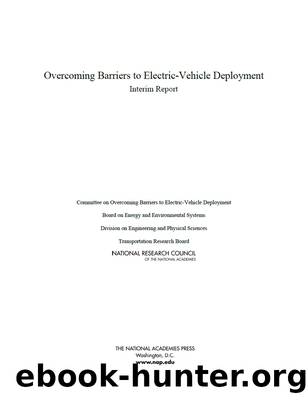Overcoming Barriers to Electric-Vehicle Deployment by Board on Energy & Environmental Systems

Author:Board on Energy & Environmental Systems
Language: eng
Format: epub
Tags: ebook
Publisher: The National Academies Press
Published: 2013-07-19T00:00:00+00:00
FIGURE 3-3 DC fast charging a Nissan Leaf. DC fast charging is able to charge a Nissan Leaf battery to 80 percent capacity in less than 30 min. The charge would typically allow a 2013 Leaf to travel about 64 miles. SOURCE: Copyright 2010 by the eVgo Network; licensed under Creative Commons 2.0 (CC-BY-2.0).
Wireless Charging
In its final report, the committee will consider the possibility of charging a PEV wirelessly. Instead of sending electricity through a cord plugged into a vehicle, the energy in wireless charging is transferred inductively from a coil attached to an electricity source to a coil attached to the vehicle; both coils are encased and out of sight below the vehicle. Although that technology is not yet widely available to consumers, wireless charging systems are in the early stages of production and availability, and new designs are being investigated (Electric Vehicle News, 2011; Plugless Power, 2013). The reduced efficiency and increased cost of wireless chargers are disadvantages, especially considering that little time is required to plug in a PEV. However, the advantages of increased convenience and reduced susceptibility to vandalism might eventually be more compelling.
Download
This site does not store any files on its server. We only index and link to content provided by other sites. Please contact the content providers to delete copyright contents if any and email us, we'll remove relevant links or contents immediately.
| Automotive | Engineering |
| Transportation |
Whiskies Galore by Ian Buxton(41941)
Introduction to Aircraft Design (Cambridge Aerospace Series) by John P. Fielding(33095)
Small Unmanned Fixed-wing Aircraft Design by Andrew J. Keane Andras Sobester James P. Scanlan & András Sóbester & James P. Scanlan(32766)
Craft Beer for the Homebrewer by Michael Agnew(18200)
Turbulence by E. J. Noyes(7983)
The Complete Stick Figure Physics Tutorials by Allen Sarah(7339)
Kaplan MCAT General Chemistry Review by Kaplan(6903)
The Thirst by Nesbo Jo(6882)
Bad Blood by John Carreyrou(6584)
Modelling of Convective Heat and Mass Transfer in Rotating Flows by Igor V. Shevchuk(6408)
Learning SQL by Alan Beaulieu(6239)
Weapons of Math Destruction by Cathy O'Neil(6220)
Man-made Catastrophes and Risk Information Concealment by Dmitry Chernov & Didier Sornette(5958)
Digital Minimalism by Cal Newport;(5707)
Life 3.0: Being Human in the Age of Artificial Intelligence by Tegmark Max(5518)
iGen by Jean M. Twenge(5387)
Secrets of Antigravity Propulsion: Tesla, UFOs, and Classified Aerospace Technology by Ph.D. Paul A. Laviolette(5336)
Design of Trajectory Optimization Approach for Space Maneuver Vehicle Skip Entry Problems by Runqi Chai & Al Savvaris & Antonios Tsourdos & Senchun Chai(5040)
Pale Blue Dot by Carl Sagan(4960)
